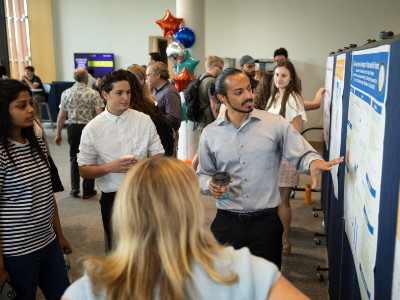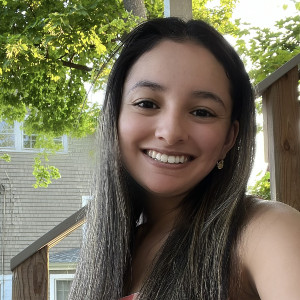More than 100 undergraduate students who have been engaged in research and scholarly and creative pursuits over the summer will present their projects and findings at a showcase being hosted virtually and on campus Aug. 9 and 10.
The event, organized by the Syracuse Office of Undergraduate Research and Creative Engagement (SOURCE), celebrates the culmination of undergraduates’ summer efforts and the array of topics they examined through many research and creative programs across campus.

A student gives a poster presentation during the 2022 event. (Photo by Angela Ryan)
The University community is invited to attend two presentation events. Nine students are presenting their work virtually on Wednesday, Aug. 9, from 2 to 4 p.m. on Zoom. Another 100 students will present in a poster session Thursday, Aug. 10, from 10 a.m. to noon at the Panasci Lounge in Schine Student Center. A celebration picnic will follow on the Huntington Beard Crouse patio.
Students include participants in SOURCE initiatives as well as other programs, including the Louis Stokes Alliance for Minority Participation (LSAMP); Chemistry and BioInspired Research Experience for Undergraduates (REU) programs; the SUNY Upstate Summer Undergraduate Research Fellowship (SURF) program; Renée Crown University Honors Program; Women in Science and Engineering (WISE)-supported students and others.
Most of the presenters are undergraduates at Syracuse, although visiting students from other colleges who have worked with Syracuse University or SUNY Upstate faculty through several programs will also share their summer work, says Kate Hanson, director of the SOURCE. Over 225 students across all the campus programs were research-active this summer, working both in-person and remotely.
Participating students are from a variety of disciplines, primarily STEM fields. Among the topics undergraduates have been examining this summer are:
- Adverse Childhood Experiences and Substance Abuse: A Literature Review and Future Directions
- A Frequency Feedback and Color Transfer Approach to Improved Coherence in Video Style Transfer With Diffusion Models
- Functional Characterization of Systemic RNA Interference in C. elegans
- Media Coverage of Sickle Cell Disease and Hydroxyurea Use, Access, Side Effects and Policy in Sub-Saharan Africa: A Content Analysis
- Solid State Solar Collector for Electricity Generation in Concrete Sidewalks
- The Role of the KIT Tyrosine Pathway in Primordial Follicle Formation in Neonatal Mouse Ovaries
“The SOURCE Summer Research Symposium brings together students working with mentors and programs across the University to share and celebrate their summer research work,” says Hanson. “By engaging in research and creative activity during the summer months, students truly focus on their projects and make immense strides while developing valuable skills and building strong relationships with faculty mentors.”
Student Researchers
Catherine Solis, a senior biology and neuroscience major in the College of Arts and Sciences, has been researching the behavioral and cognitive effects of early life adversity in adolescent CD-1 mice through maternal separation with Catherine Cornwell, associate professor of psychology. “I am focusing on how spatial and working memory deficits develop over time in the mice to adulthood in order to correlate how early life adversity in humans (neglect, abuse and the foster care system) affect human children in real life,” Solis says. “Ultimately, our lab aims to understand the environmental and social factors leading to the development of such cognitive disorders as ADHD [attention-deficit/hyperactivity disorder].”

Catherine Solis
Solis has also worked on projects in the lab studying the effects of both pharmacological and nonpharmacological solutions, and plans to begin drug studies to determine the difference in environmentally induced early life adversity mouse models and drug induced models.
She is a participant in the LSAMP program, which promotes educational opportunities for students from underrepresented communities to study and pursue careers in STEM fields.
“I have been with LSAMP for a year now and I’m excited to continue with it for my senior year; the program has greatly contributed to my professional development in college so far and preparation for graduate school applications,” Solis says. “LSAMP has allowed me to grow as a student and researcher, participate in and present at two national conferences and has led me to realize I wanted to pursue a Ph.D. in neuroscience after my undergraduate studies.”
Mrigayu Ghosh, a sophomore biomedical engineering and biochemistry major at the University of Texas (UT) at Austin, has engaged in research with Zhen Ma, associate professor of biomedical and chemical engineering and Samuel and Carol Nappi Research Scholar in the College of Engineering and Computer Science, through the Interactive Biomaterials REU program. Shikha Nangia, the program’s director, played a pivotal role in securing funding for the grant.

Mrigayu Ghosh
Ghosh, a seasoned researcher through previous opportunities, has been working on the purification and characterization of extracellular vesicles from mesenchymal stem cells for applications in tissue regeneration.
“I’ve wanted to research stem cell biology for a long time, so I’m really fortunate to have this experience,” he says. “I love the potential of stem cell research and am looking forward to bringing back what I’ve learned to UT and continuing my research in Dr. Aaron Baker’s lab, which studies the mechanobiology of stem cells.”
After graduating from UT, Ghosh plans to pursue a Ph.D. and embark on a career as a professor. “I’m grateful to have enhanced my research, writing and presentation skills throughout this program as all the skills I’ve acquired will be highly relevant in my academic and professional career moving forward,” he says.
Quinn Carletta, a sophomore graphic design major in the Newhouse School of Public Communications, has been working with fellow students Michaela Fry and Mattea Vecera and J. Christopher Hamilton, assistant professor of television, radio and film, on research for a documentary film through the SOURCE Research Assistant Grant. Carletta has worked to creating slide and presentation decks and social media content.
“Working with Professor Hamilton has given me a new perspective on how I can work with clients in the future,” Carletta says. “Similarly, it has impacted how I approach working on new projects since I have a better grasp on the questions to ask before starting a design request now.”
Other Presentations
The iSchool Summer REU fellows and their mentors spent the summer working on 12 cutting-edge computational social science research projects. They shared their findings during an interactive poster session on July 28.
Also on Thursday, Aug. 10, five McNair Scholars will present their summer research beginning at 1 p.m. in 241 Sims Hall. The University community is invited to attend.
By: Kelly Rodoski
